Go
to Astronomical Viewing Blog Archive
Go To the Beginning Post
December 27, 2015
I hope all of you had a Merry Christmas. Here
at Dry Creek View Observatory, we had a White Christmas with
another 6 inches of snow on Christmas Day. That makes about
24 inches in December. Fortunately most of it melted between
snow falls so we only have about 6 inches on the ground. Since
it has been cloudy, I have been working on a new Logo for
the observatory. It is shown below and will appear on each
of my web pages. I will get back to observing and picture
taking when the skies clear.
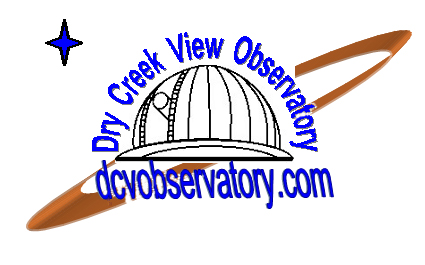
New Dry Creek View Observatory Logo
December 20, 2015
We have had 14 inches of snow at the Dry Creek
View Observatory and no clear nights. Therefore, I have
been working on my Tutorial Section of the web page. I posted
a PDF file on how to connect Celestron GO TO Mounts for
telescope control in Stellarium. Check it out and see if
it works for you. I would appreciate any comments to make
it better.
November 27, 2015
During the past few months, I have been traveling
a lot for my “Day Job”. On one particular flight,
I met a person who does programming for Web Pages. She looked
at my site and offered a few suggestions. One suggestion
is that I put “Higher Resolution” images in
the gallery. I have done this with the “Orion and
Running Man” image. As time goes on, I will continue
to make changes to the site to make it better.
I know I have taken many images of M 42, but it seems to
call to me when I am taking pictures. It is a challenging
object to take pictures of and I keep trying to make it
better. The picture below is my latest attempt. It is getting
better but still not perfect.
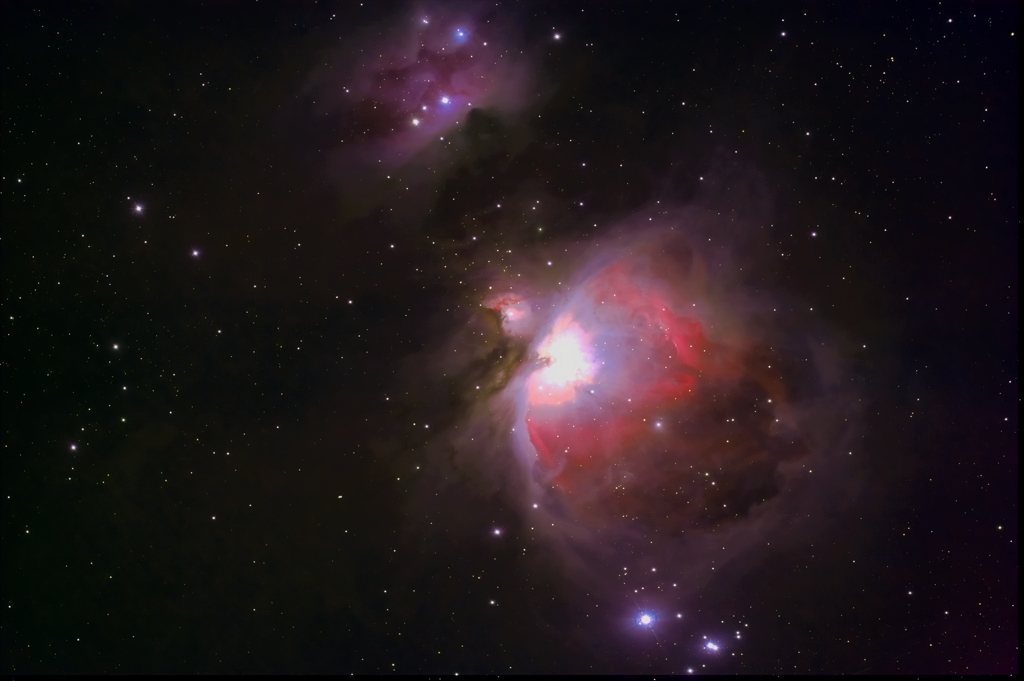
M 42 and NGC 1977 Running Man
A larger "High Resolution" Image
is in the Gallery.
September 30, 2015
Early Sunday Evening, I ventured to the observatory
(150 feet from my house) to try and get a shot of the last
Super Moon of the Tetrad. I decided to use my son's Nikon
D800 camera as I am considering purchasing the D810. The
D800 is an amazing camera and worked perfectly. As the moon
rose over the eastern mountains, the eclipse had already
started. I rushed to get the moon in sharp focus so I could
be ready for the full eclipse. I believe this is my best
picture yet of an eclipse. Shooting through my HyperStar
Lens, I was able to shoot at f/1.9 and an ISO of 100. The
shutter duration was only 3 seconds. The results are below.

Blood Moon 9-27-15
The above picture does not do the photo justice
as the shrinking of the image creates distortions around
the edges. To get a larger view without the distortions,
see my Astrophotography Gallery under "Solar System".
It is worth the view.
September 26, 2015
Time for my monthly blog update. I have had
fun this last month taking pictures and viewing. My target
of choice this month was the Cocoon Nebula IC 5146. I took
26 photos and stacked them. I really love the HyperStar
Lens. The result is below. You can see a larger picture
in the Gallery. Notice the abundance of stars as compared
to the Sculptor Galaxy Below. The Cocoon Nebula is the constellation
Cygnus which is in the middle of the Milky Way. Thus the
abundance of stars. The photo was taken on September 8,
2015.
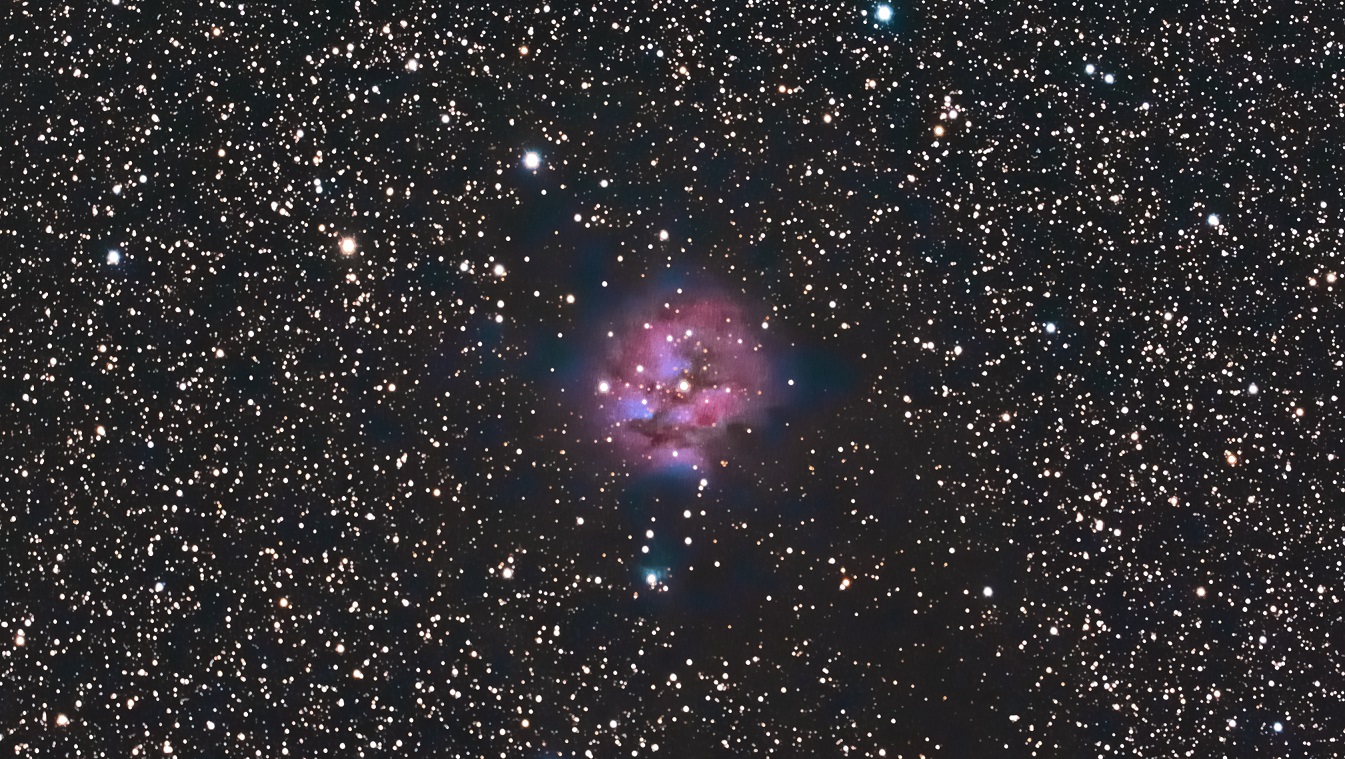
IC 5146 Cocoon Nebula
August 15, 2015
New Moon Thursday night and I wanted to see
if I could see the tail end of the Perseid Meteor Shower.
The shower proved to be a bust on Thursday, but I was told
Wednesday was awesome. The problem was "CLOUDS"
Wednesday Night. It cleared around 12:30 AM but as I had
to get up at 5:00 AM and I gave up. I was told it was awesome.
So, with no showers on Thursday, I turned to the Camera.
I always wanted to take a second picture of the Sculptor
Galaxy NGC 253 with my modified Nikon D5200. I used the
HyperStar lens and the results are below.
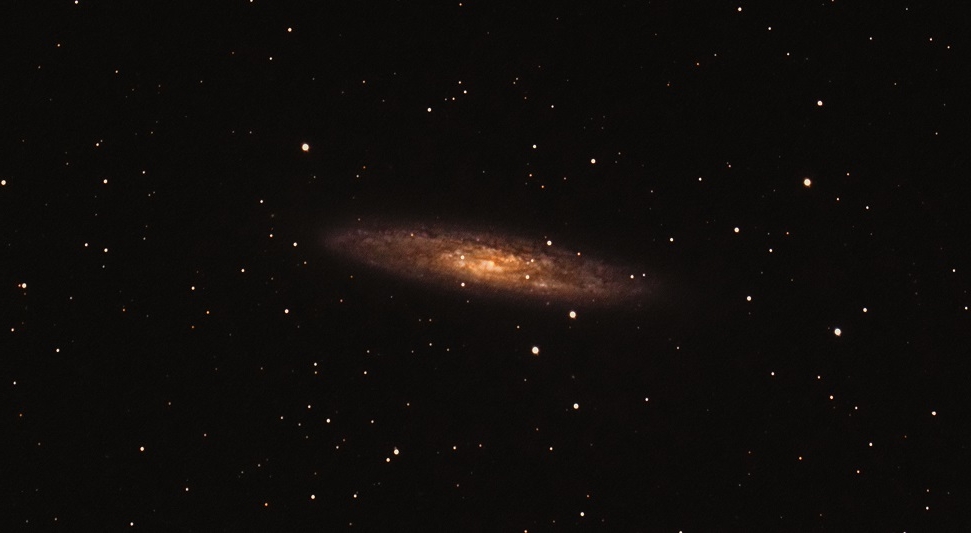
NGC 253 Sculptor Galaxy Cropped and Zoomed.
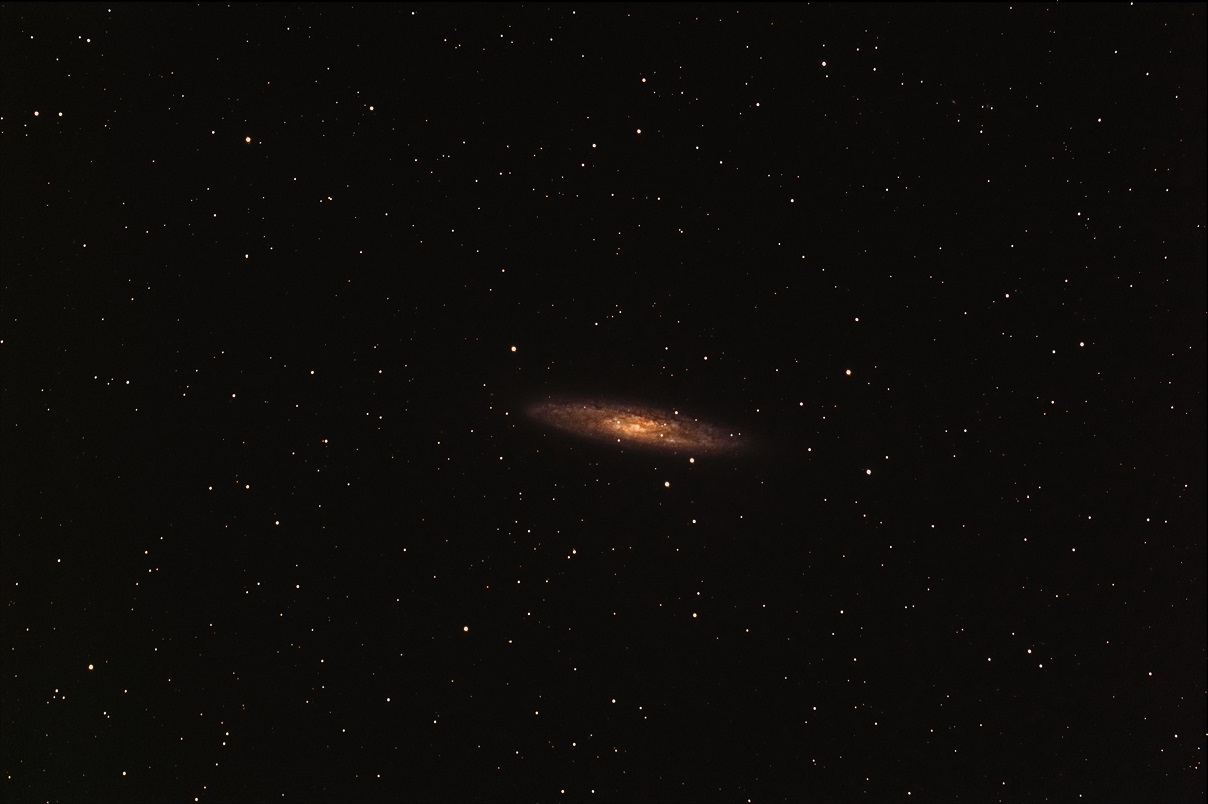
NGC 253 Sculptor Galaxy Full field of view.
The images can be seen in the Gallery for
a larger view. These images are much more crisp and the
stars are round. I had some problems with the "Roundness"
of the stars when I zoomed in. I rebalanced the scope and
the problem seems to be solved. It is hard to tell from
these small pictures, but the roundness and detail can be
seen in the Gallery.
July 19, 2015
I finely got a chance to do some photography.
It was Friday night, and it was very clear, but had a strong
wind from the south. I'm glad I braved the wind, as the
next few days have been cloudy. As my target for the evening
I chose M 27 the Dumbbell Nebula.The actual picture of the
nebula turned out OK, but I am not pleased with the "Egg"
shaped stars. I was autoguiding, but my Starshoot guider
camera is having problems and kept losing its star lock
by losing communication with my computer. I'm not sure if
this was the cause, or my scope is out of balance when using
the HyperStar Lens. I am investigating a new camera for
my autoguiding. Below is a picture of the nebula. A larger
version can be seen in the Astrophotography Gallery.
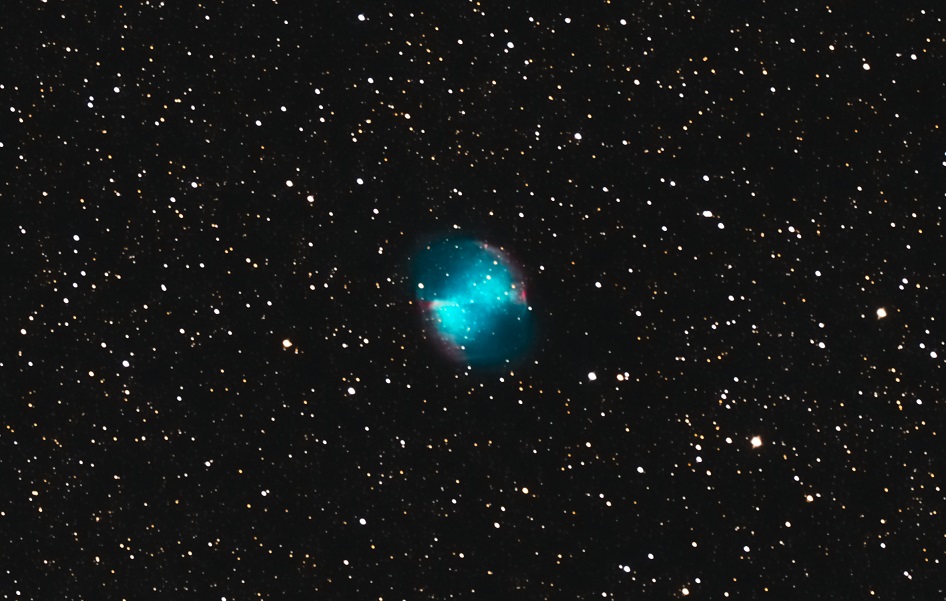
M 27 Dumbbell Nebula
July 10, 2015
The month of June was hectic in my life with
the "Day Job" taking me away from the observatory
and cloudy weather rolled in when I was home. That said,
I did find time for some outreach programs with many people
coming over to view the heavens. I wasn't able to take any
pictures, but I did allot of viewing with those who came
to visit the Observatory. One night I had about 15 girls
from a Young Women's group along with their leaders. I showed
them how the planets move along the Ecliptic and where the
Meridian cuts the Eastern Sky from Western Sky. I told them
how to find the North Star and then we looked at the Moon,
Venus, Jupiter, Saturn and M13. The moon was too bright
to see any Deep Sky objects with any clarity. The information
I gave them was enough to pass off requirements for their
"Girls Camp" in Astronomy. I also got to use my
new laser to point out the constellations and planets. See
my Equipment tab to get more information on the Laser.
Next I had three families who wanted to see
the Observatory. We looked at the same objects as I did
with the Young Women. All in all, it was fun, even if I
didn't get a chance to take pictures.
May 24, 2015
I haven't forgotten about astronomy, these
past few weeks, but it has been really rainy at the Dry
Creek View Observatory. The few nights that it cleared off,
the moon was bright in the sky and not conducive to picture
taking.
Last night on May 23, My nephew and his family
came for a visit on their way to Disneyland. The skies miraculously
cleared and we were able to observe Saturn, Venus, Jupiter,
M 13 and the Crescent Moon. It was a fun evening, but no
picture taking.
April 19, 2015
My day job is really busy this time of year
and it has precluded me from doing any photography. However,
I have had a few people over to the observatory to do some
viewing and was able to capture the Lunar Eclipse on April
4.
Alignment Problems
Even with being busy, I did some alignment
of my scope. For those who have Celestron CGE mounts and
presumably other GOTO mounts from Celestron, I have found
that after a few months the GO TO alignment starts to drift
and objects are no longer centered. This only applies to
those who have permanently mounted scopes and constantly
use the "Hibernate" function of the controller.
I attribute this to the change of seasons resulting in the
changing of the constellations in the night sky. As the
constellations set in the west, the alignment naturally
introduces some error. To overcome this, I do a realignment
of my scope every three months. I have also found, that
after a few alignments, the alignment stars are not even
close to where the scope thinks they should be. On other
forums, I have noticed that this occurs with other celestron
users as well. To overcome this problem, you must do a "Factory
Reset" of the mount. This clears all of the memory
in the controller and you must reenter your location and
time. Once I do this, the Alignment Stars are once again
close to where the scope thinks they should be and almost
always in the "Finder Scope" field of view. I
attribute this problem to memory overflow when using the
"Hibernate" function repeatedly and then doing
a realignment. The scope tends to get lost unless the memory
is refreshed. This may not be the cause, but it is my best
guess. It really doesn't matter as the reset of "Factory
Settings" solves the problem. So for you users with
permanently mounted scopes, Do a "Factory Reset"
if your scope cannot find the Alignment Stars.
March 20, 2015
Last night was a great night for taking pictures.
Clear dark skies, no wind and warm. I focused my task again
on Jupiter. I am still not satisfied with the outcome and
more processing is needed. For me planets are hard, they
seem to take allot of practice.
After my foray with Jupiter, I decided to
turn my attention to NGC 3242 which is the "Ghost of
Jupiter" This planetary nebula is in the constellation
Hydra. I took 20 pictures, but my Deep Sky Stacker (DSS)
would not stack them as there were not many stars in the
area to get a good reference for stacking. Fortunately,
I was able to capture the nebula at ISO 800 with my D5200
camera. The noise is minimal, and the results of Cropped
and uncropped images are shown below. I cropped the image
to show more detail.
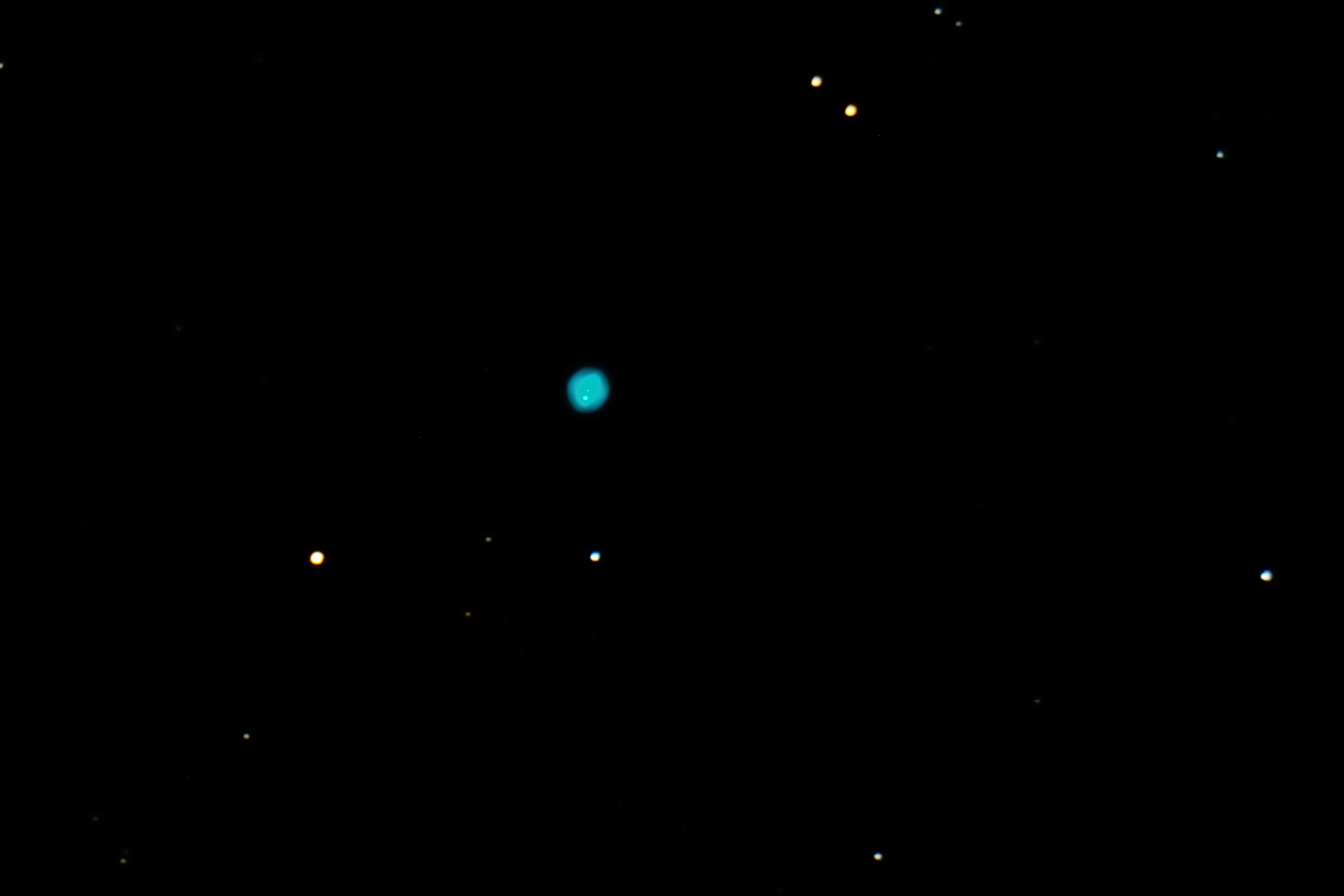
NGC 3242 Ghost of Jupiter Uncropped
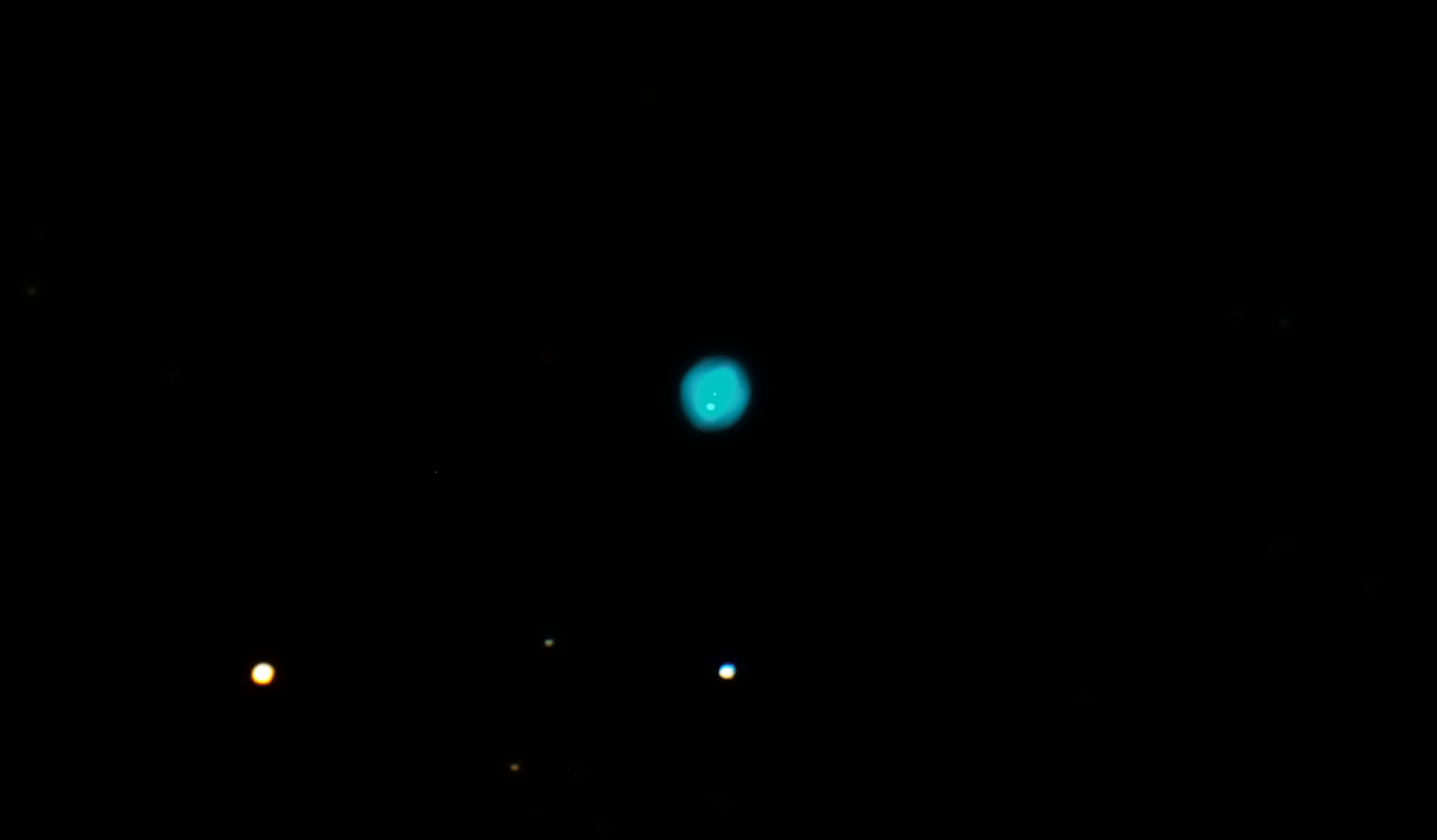
NGC 3242 Ghost of Jupiter Cropped.
I have placed the Cropped version in the Gallery
so you can see the detail of the nebula
March 13, 2015
Today I got a chance to process and post some
pictures I took awhile back. The first is Stephens Quintet
along with NGC 7331 in the same picture I took the picture
on September 1, 2014. I count 22 galaxies in that photo.
Check out the Gallery and see how many galaxies you can
count.
The next photo I took and just processed was
Galaxy NGC 2403. I took this picture on February 12, 2015
and I have posted this in the Gallery.
February 21, 2015
I have had allot of fun this past week. With
the moon dark, and clear skies, I was able to get good shots
of the Comet Lovejoy at ISO 400, the Convergence of the
Moon Mars and Venus and I took some time to just view the
heavens. On February 18, I had a friend, Saif Mogri from
Los Angeles and Lee Tanner from Delta Utah to see the sights.
The moon was dark, but we were able to see various galaxies,
Jupiter and M 42. It was a great night. On February 20,
I was driving home from visiting family in American Fork
Utah, when I saw the convergence of the Moon Mars and Venus.
I new I only had about 30 minutes to get a picture before
the convergence would be too low in the western sky. I barely
made it. The results of Comet Lovejoy at 400 ISO and the
Convergence are shown below. In the Gallery, a larger version
of each picture is shown. About two inches to the right
of the comet and just above the tail, Galaxy NGC 746 can
be seen.
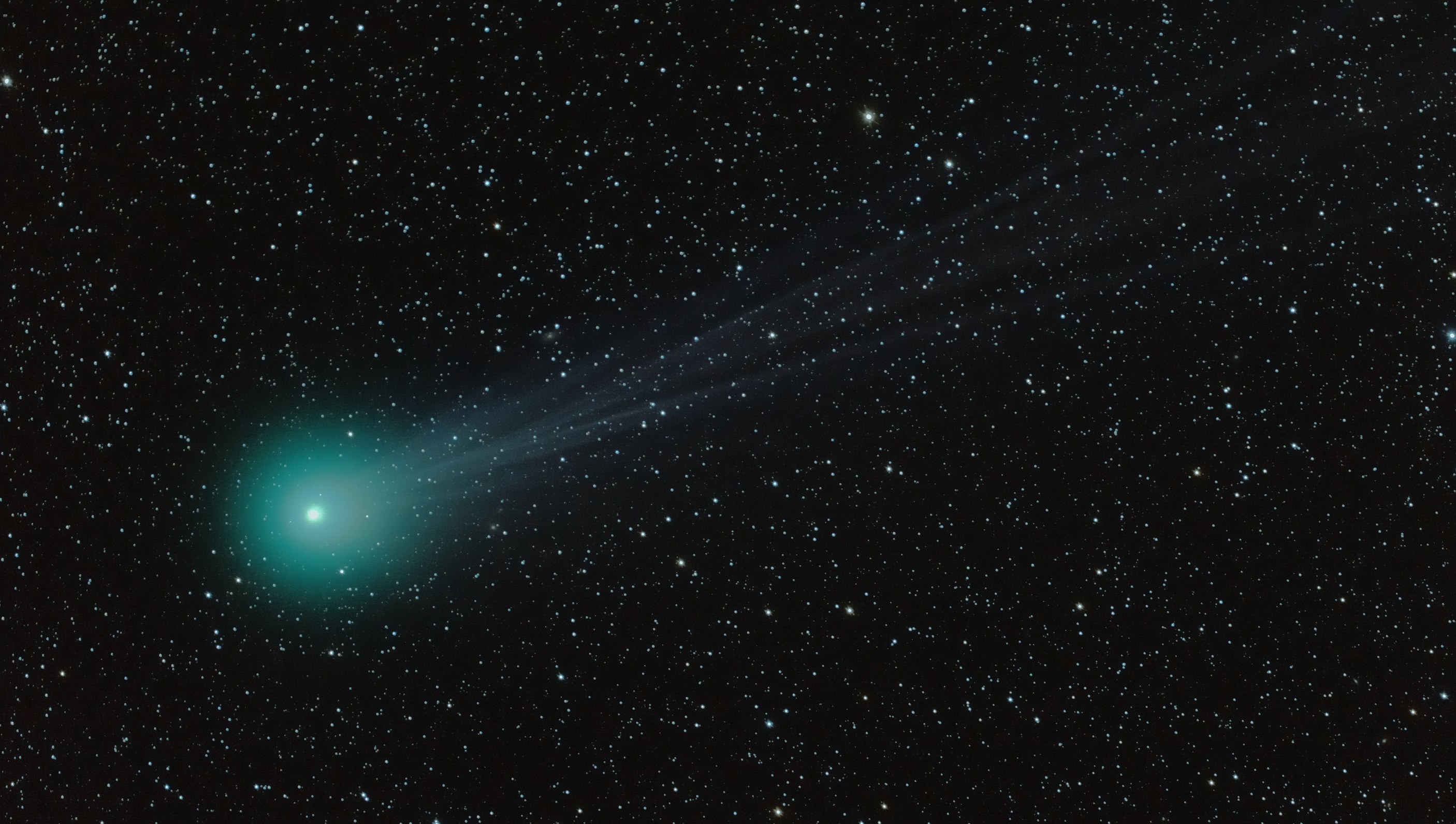
Comet Lovejoy at ISO 400
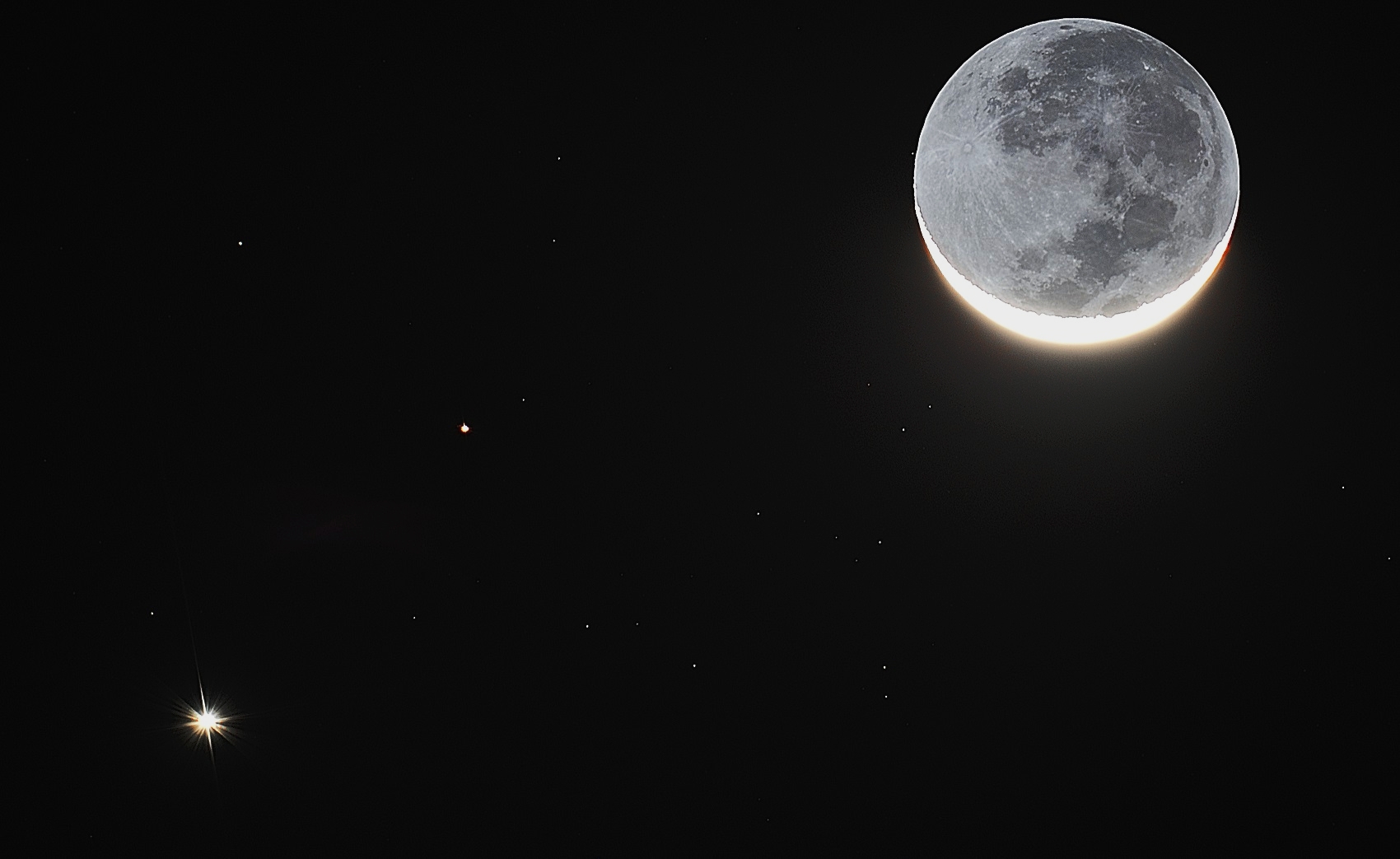
Convertence of Moon Mars and Venus
January 31, 2015
Clouds, rain, light snow and the moon have
precluded me from taking my ISO 400 picture of Comet Lovejoy.
However it has given me time to post process a shot of M
78 in the constellation Orion. I took this shot on January
22 and just got around to the post processing. I took time
with this and made sure that I did not blow out the highlights.
The stars illuminating the nebula can still be seen in the
photograph. I had to walk a fine line between getting cloud
detail and not washing out the stars. The result is below.
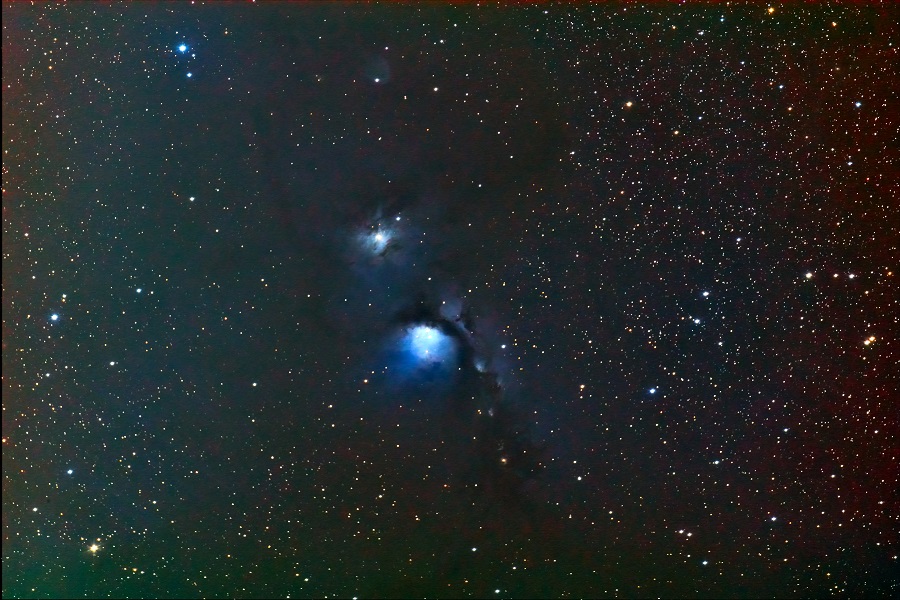
M 78
I have placed this image in the gallery so
that a larger picture can viewed.
January 24, 2015
Thursday Night was my night to try another
attempt at Comet Lovejoy. This time I used a longer exposure
to try and capture more of the tail. I used the same ISO
setting of 800, but this time I took the shot with a shutter
speed of 2.5 minutes. I did manage to get better detail
of the tail, but I found when stacking the comet using Deep
Sky Stacker in "Comet Mode", the resultant image
was too dark and again I lost detail of the comet. I experimented
and found I had a better picture using only 1 frame. This
however resulted in allot of darkness around the edges of
the photo because I did not stack with any Flat Frames".
Therefore, I choose my best light frame, and stacked it
in DSS with 1 flat frame. This eliminated the dark corners
of the photo, and gave me the best view of the tail. My
results are shown below.
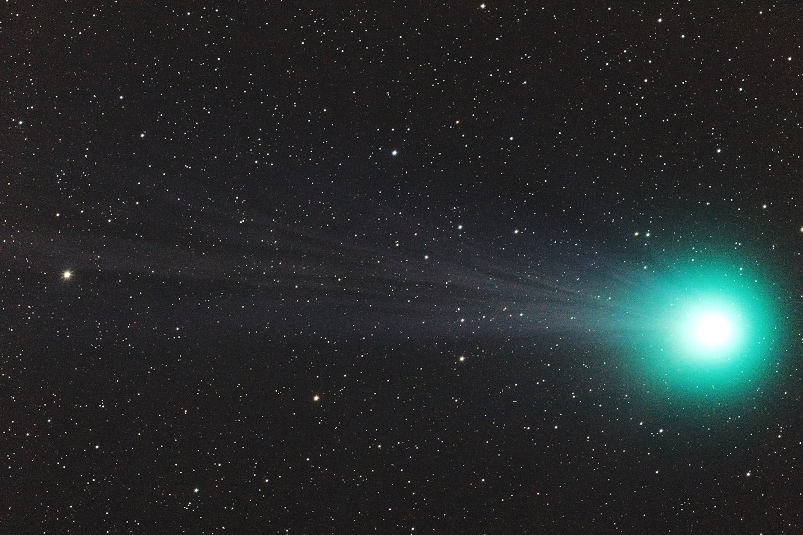
Comet Lovejoy
Compared to my picture below, taken on January
18, I did achieve my goal of getting more tail detail. However,
since there is only 1 picture stacked with a flat the noise
level is a little higher. If I get another chance, I will
try again with my ISO set at 400 and a shutter speed of
5 minutes. This will give me an equivalent exposure, but
hopefully less noise. Presently I have not posted this in
my gallery as I am not satisfied with the noise level. If
I can get the noise down, I will post the better photo so
you can see a larger image.
January 18, 2015
This is my first post in 2015. The holiday
season was good to me, and I gained 5 pounds. The food was
great, but the the skies did not cooperate. However, on
January 17, I did have clear skies and was able to take
my first shot or attempt at Comet Lovejoy. I have not posted
this in my gallery as I am not satisfied with the results
especially with the tail. I took the picture with my D5200
Camera and the HyperStar lens. Even with the HyperStar,
I was just barely able to capture the comet and all of its
tail. The picture is stacked with Deep Sky Stacker. I took
20 light frames at 20 seconds each. I think I need to increase
the exposure time to around 1 minute to get a good shot
of the tail. Perhaps next weekend I will give it a try.
Below is Comet Lovejoy. If you look carefully, you can see
the tail.
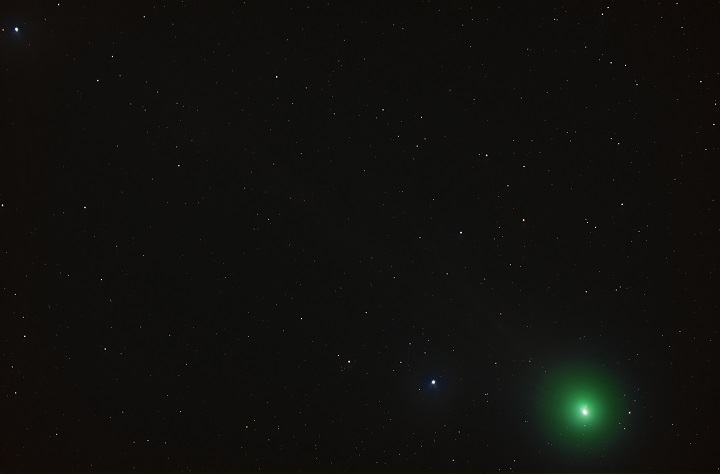
Comet Lovejoy
|

